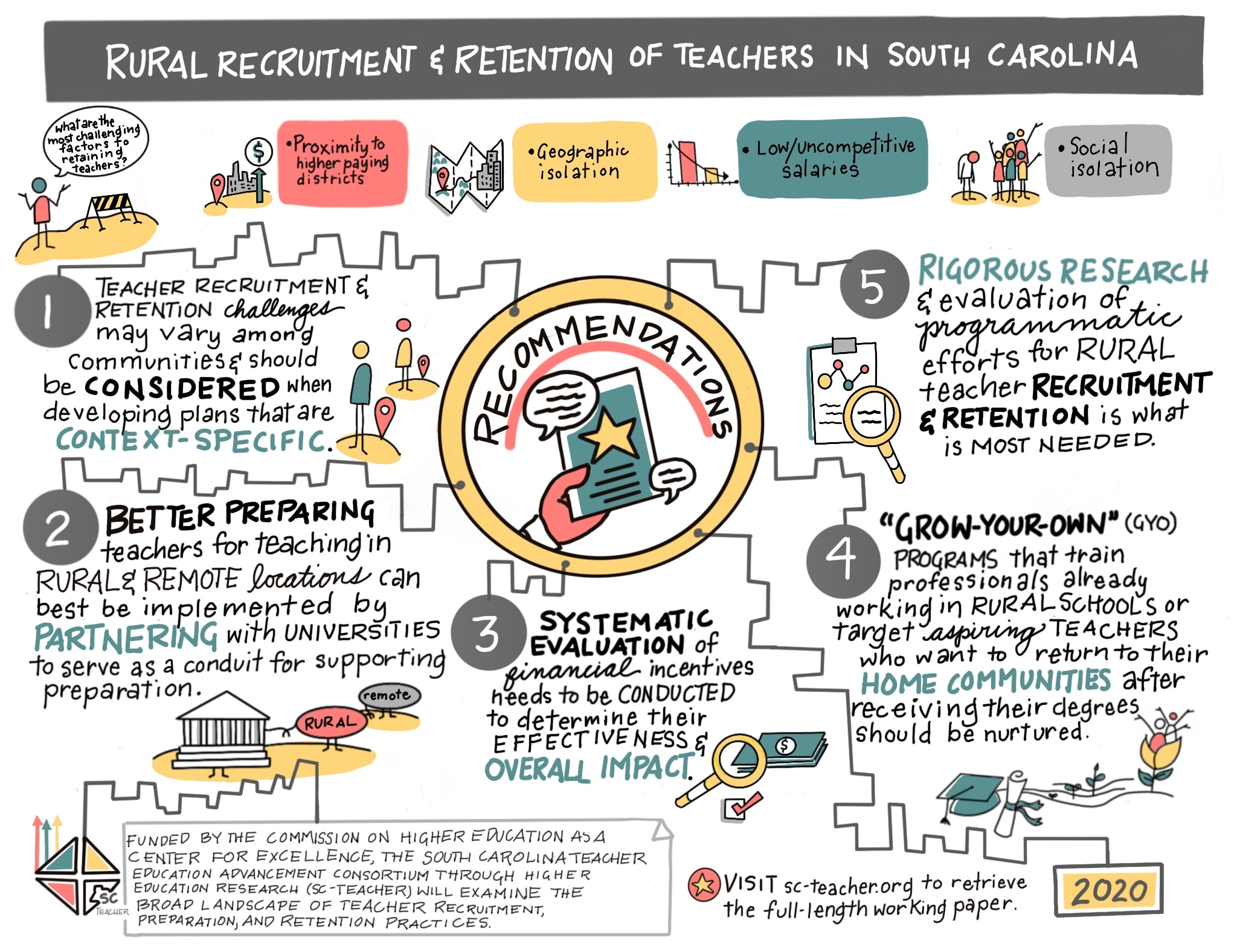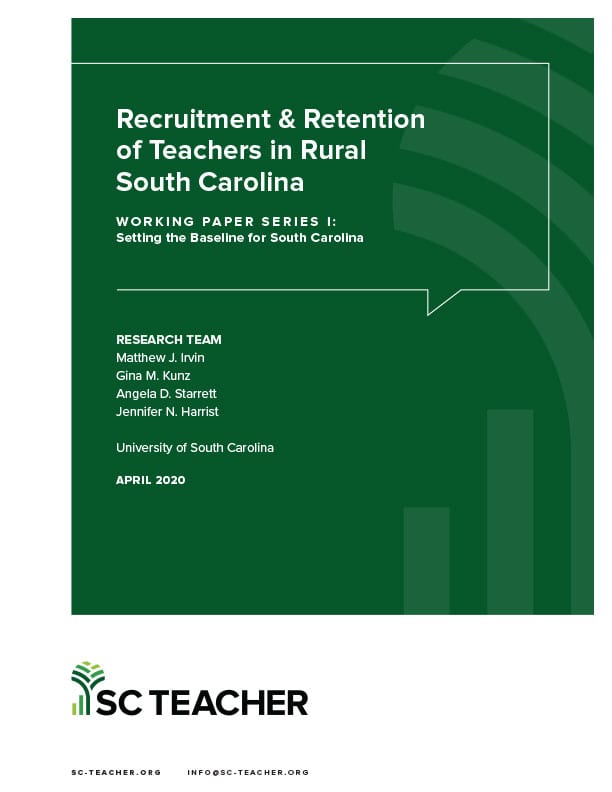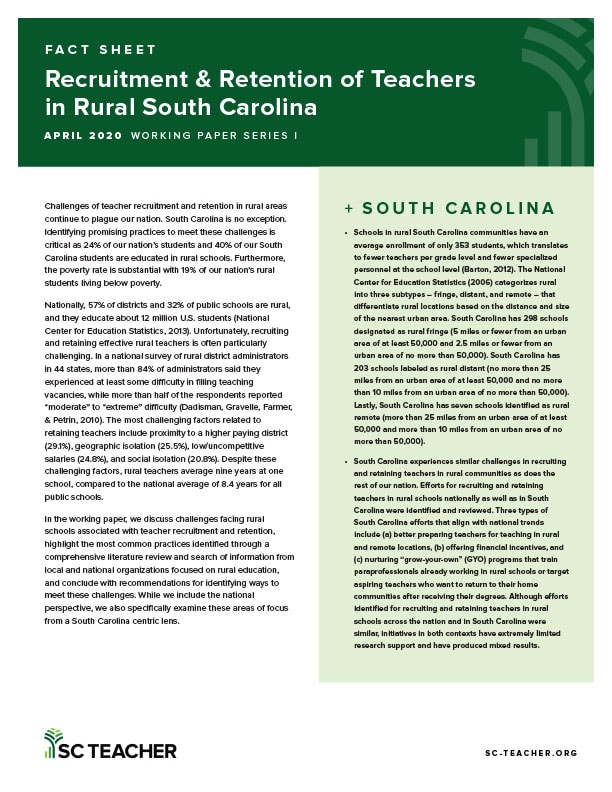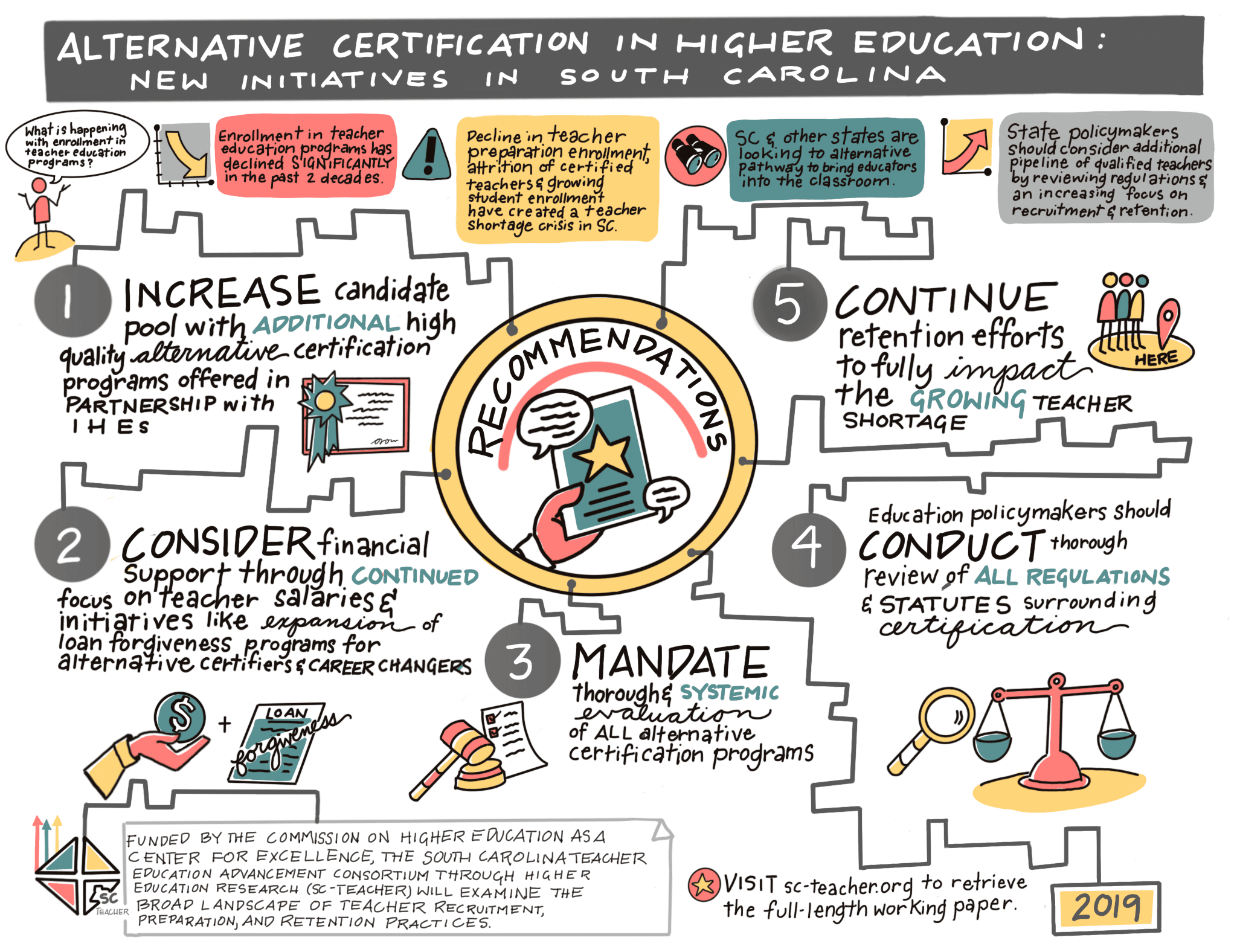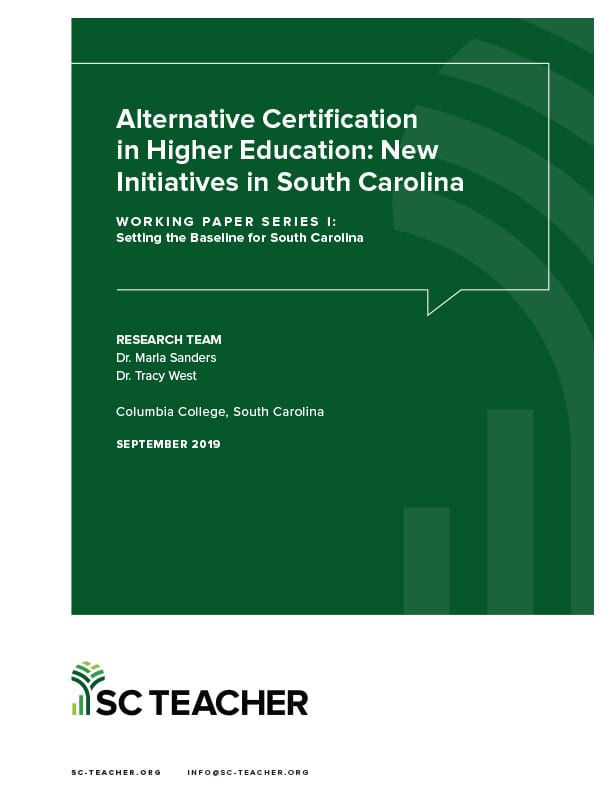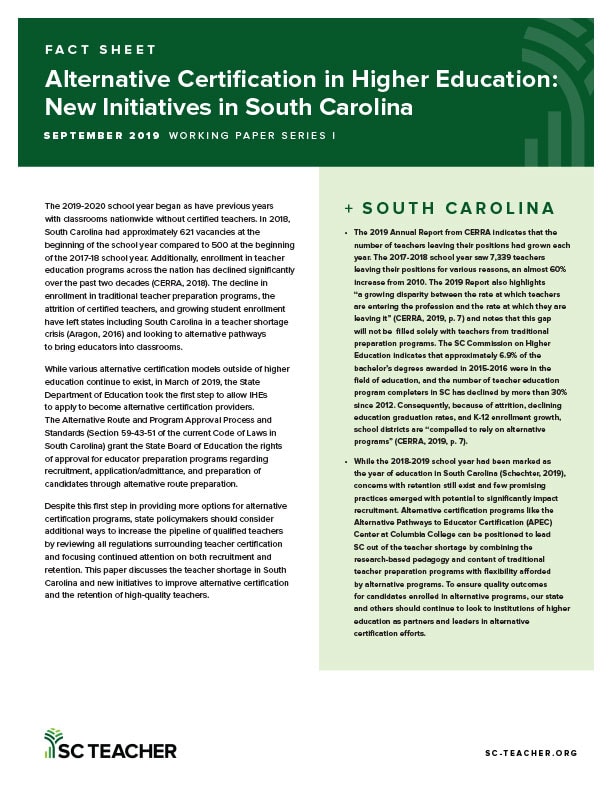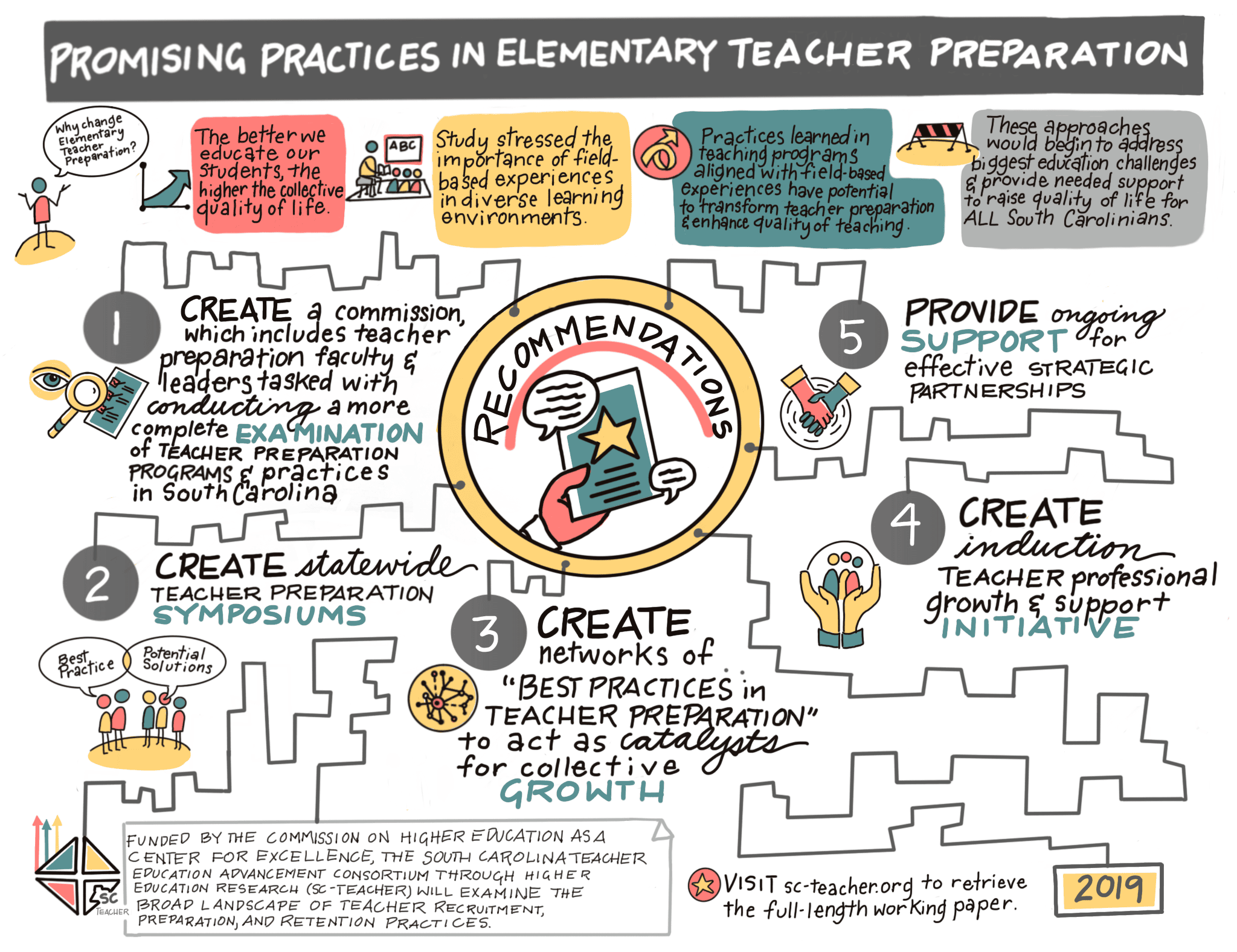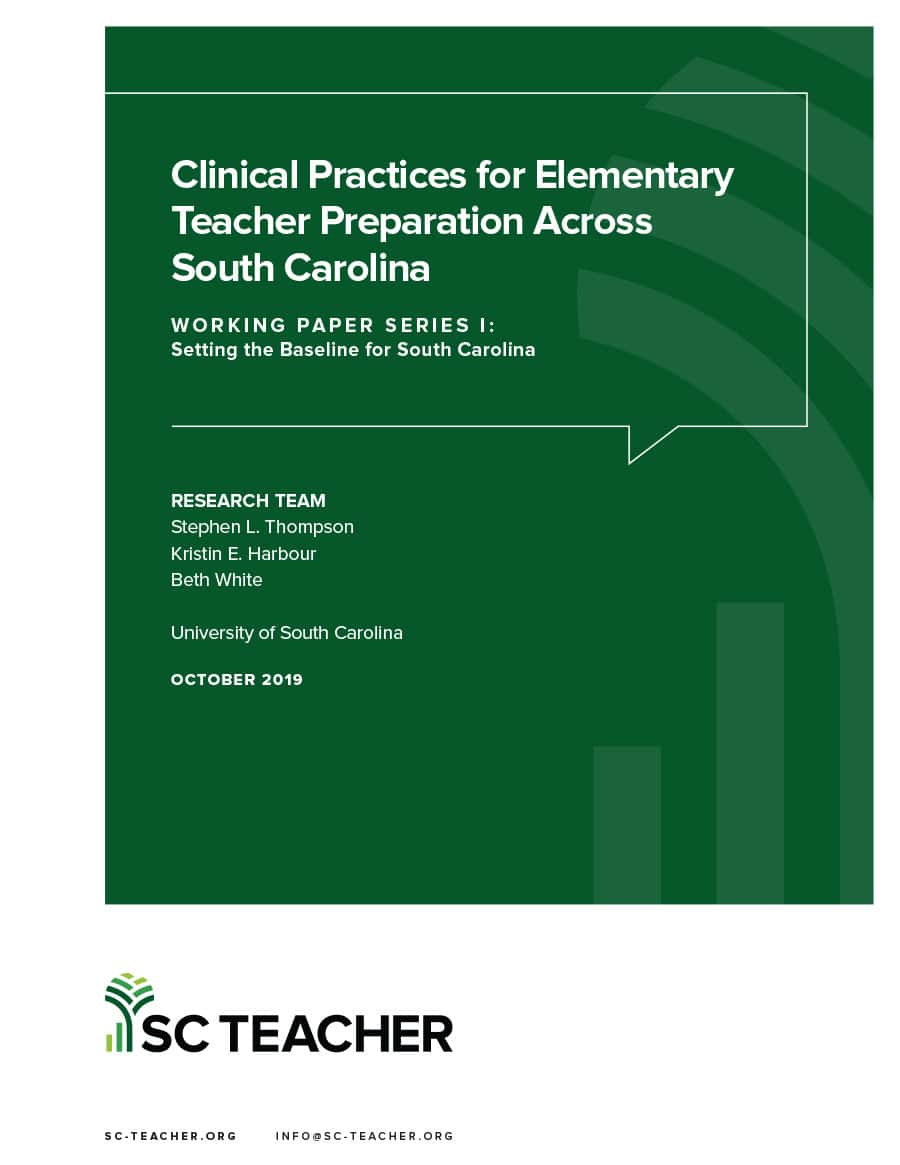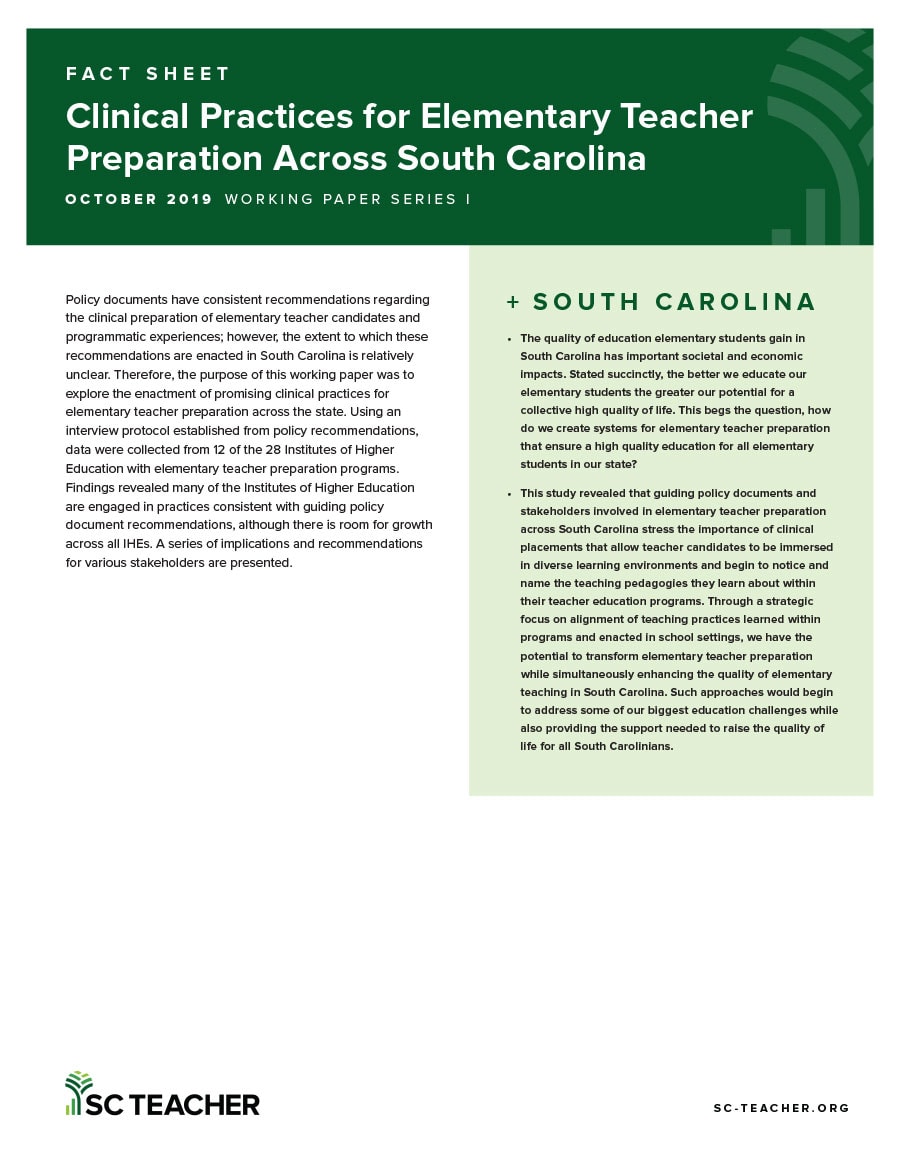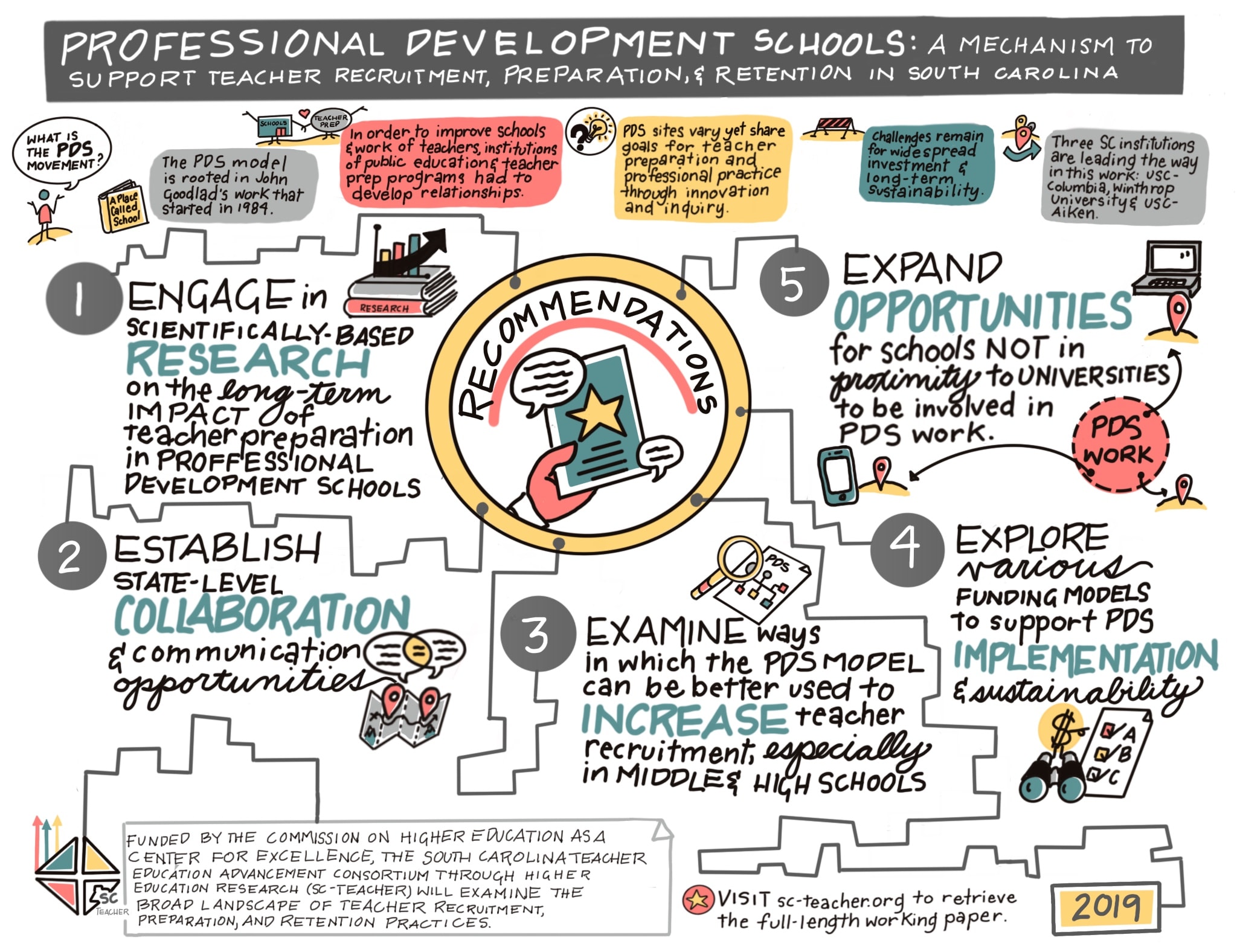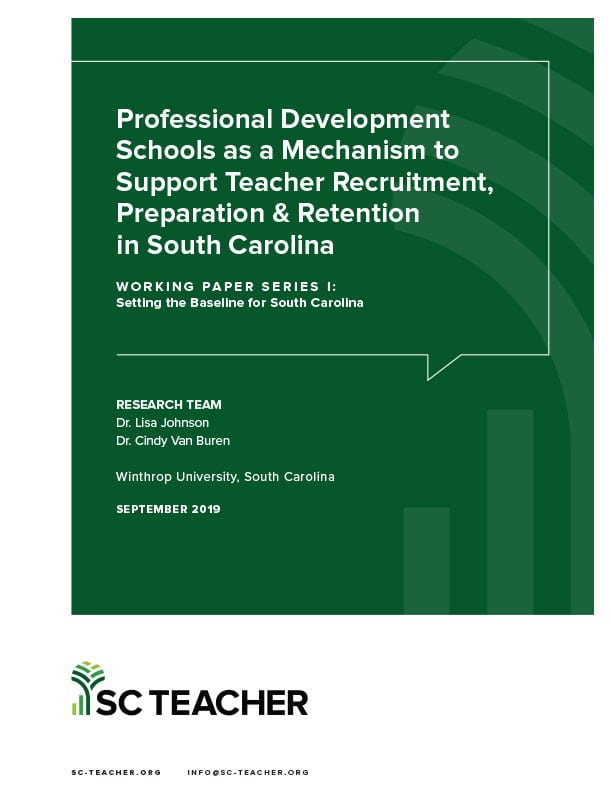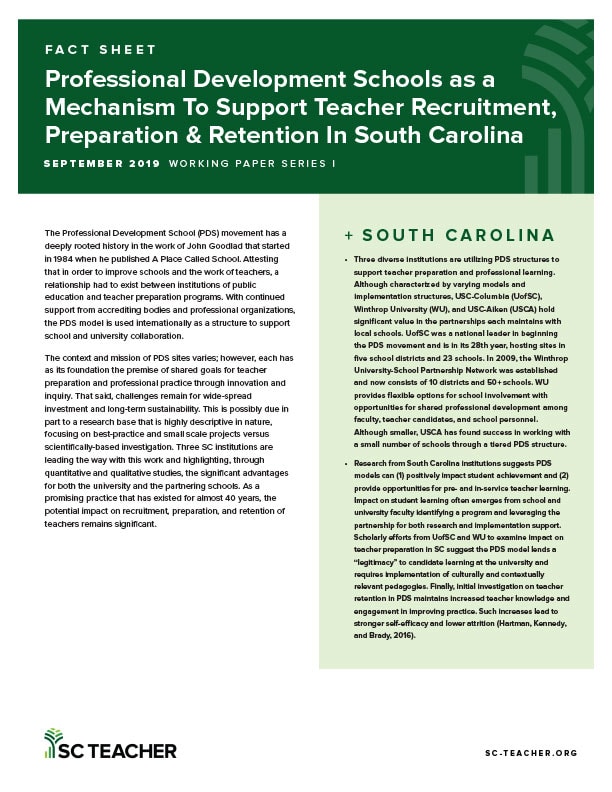Recruitment and Retention of Teachers in Rural South Carolina
ABSTRACT
Challenges of teacher recruitment and retention in rural areas continue to plague our nation. South Carolina is no exception. Identifying promising practices to meet these challenges is critical as 24% (12 million) of our nation’s students and 40% of our South Carolina students are educated in rural schools. In this paper, we discuss challenges facing rural schools associated with teacher recruitment and retention, highlight promising practices identified through a comprehensive literature review, and conclude with recommendations for meeting these challenges. While we include the national perspective, we also specifically examine these areas of focus from a South Carolina centric lens.
ROUNDTABLE: Focusing On Our State's Retention Issues
How are issues of teacher retention impacting students and schools in South Carolina?
What are educators and public education advocates doing to increase retention in the profession?
What impact are those strategies having on teacher retention?

Like many other states across the country, South Carolina had an increasing number of teachers leaving the profession - until this past year. According to the 2019-2020 South Carolina Annual Educator Supply and Demand Report, released by the Center for Educator Recruitment, Retention, and Advancement (CERRA), this school year 6,650 teachers did not return to a teaching position in the same district that they were in during the 2018 - 2019 school year, a 9% decrease. While schools and districts filled most of those vacancies, there were still 555.5 vacant positions at the start of the ’19-’20 school year. That number of vacancies represents an 11% decrease from the prior year that, while promising, means that thousands of South Carolina’s children started school without a certified teacher.
The good news is that SC-TEACHER was created to study the issue of retention (in addition to recruitment and preparation) so that practitioners and policymakers can make strategic decisions based on more sophisticated data and analyses.
Over the next several weeks, blogs featured in this roundtable will set the stage for urgent action, then share current efforts taking place to address the issue of teacher retention.
Please join the conversation and share your thoughts and experiences by commenting on these blog posts and inviting your colleagues to join the discussion on social media with @SCTEACHERTweets. Follow SC-TEACHER on Twitter to see when each new blog is posted.
 Featured February 18, 2020:
Featured February 18, 2020:
The House is On Fire by Patrick Kelly, Coordinator of Professional Learning in Richland School District 2 (On Twitter: @plkelly27)
 Featured February 25, 2020:
Featured February 25, 2020:
CarolinaTIP: A Promising Solution to the Teacher Shortage By Nicole Skeen, University Induction Coordinator | UofSC College of Education @eneskeen
F eatured March 3, 2020:
eatured March 3, 2020:
Policy Discussion on Preparation, Recruitment and Retention of Teachers by Melanie Barton, Executive Director – South Carolina Education Oversight Committee
 Featured March 19, 2020:
Featured March 19, 2020:
Let’s Talk About That: Teacher Retention by Cindy Van Buren, Assistant Dean for Professional Partnerships, University of South Carolina, @Cindy_Van_Buren
Alternative Certification in Higher Education: New Initiatives in South Carolina
INTRODUCTION & RATIONALE
The 2018-19 school year began as the previous year with classrooms nationwide without certified teachers. In South Carolina, there were approximately 621 vacancies compared to 500 just one year ago for the 2017-18 school year as reported by the Center for Educator Recruitment Retention and Advancement (CERRA, 2018). In addition, a review of enrollment in teacher education programs across the nation indicates that the number of individuals entering traditional certifying programs has declined from what to what from when to when. In response to these events, policy makers are considering ways to increase the pipeline of qualified teachers, including the development of alternative teacher certification pathways that are offered by higher education institutions.
CarolinaTIP: A Promising Solution to the Teacher Shortage
When my husband and I found out we were expecting, we did everything in our power to prepare. We read books, attended classes, and sought the advice of experts. Over weekends, we even borrowed our friends’ children in an attempt to hone our pre-parenting skills. Unsurprisingly, as any parent knows, nothing (and I mean nothing!) could have prepared us for the fatigue, concern, stress, and self-doubt that stems from the reality of raising three boys.
 For teachers, the journey of stepping into their own classrooms for the first time follows much the same trajectory of bewilderment and exhaustion faced by new parents. Many enter the profession with the tools and knowledge required for success. However, new teachers often find themselves at a loss for how to effectively wield these tools as they learn how to make more than 1,500 decisions per day, navigate the needs of 20 to 30 students simultaneously, assimilate into a school culture, and balance increasing demands – all without breaking under the pressures of accountability mandates. The numerous challenges new teachers face are substantiated by a myriad of research and data including:
For teachers, the journey of stepping into their own classrooms for the first time follows much the same trajectory of bewilderment and exhaustion faced by new parents. Many enter the profession with the tools and knowledge required for success. However, new teachers often find themselves at a loss for how to effectively wield these tools as they learn how to make more than 1,500 decisions per day, navigate the needs of 20 to 30 students simultaneously, assimilate into a school culture, and balance increasing demands – all without breaking under the pressures of accountability mandates. The numerous challenges new teachers face are substantiated by a myriad of research and data including:
- Studies that show the need for and promise of induction support models (Bastian & Marks, 2017; Ronfeldt & McQueen, 2017);
- Research that points to job stress, job satisfaction, and a diminished sense of self-efficacy as early indicators a teacher will leave the profession (Dicke et al, 2014; Hong, 2010; Tait, 2008; Zee & Koomen, 2016); and
- South Carolina’s teacher shortage crisis as illustrated in Patrick Kelly’s The House is on Fire.

At least 17 % of teachers leave the profession altogether within the first five years of teaching (Gray & Taie, 2015). In South Carolina, the situation is equally dire. A total of 5,300 SC teachers exited the profession at the end of the 2017-2018 school year. Almost half of those leaving the profession were induction teachers with five or fewer years’ experience. Alarmingly, a full quarter of first year teachers left the classroom during or at the end of the 2017-2018 school year (CERRA, 2018). These numbers paint a grim picture. One that reveals an urgent need to identify and provide the type of support required to not only keep our newest teachers in the classroom but also enable them to cultivate the confidence, resiliency, and grit needed to thrive in the profession.
Simply put, the essential question is: How can we support teachers through the inherent growing pains of their induction years in order to unlock their full promise and potential in the classroom?
The University of South Carolina College of Education’s Carolina Teacher Induction Program (CarolinaTIP) is making strides toward answering this critical question. In its third iteration, the university-based induction program currently provides supplemental, comprehensive, holistic, and teacher-centered support to more than 100 teachers across six school districts.
Read more about the program in the news:
A Case for Teacher Mentoring, Coaching and Induction Support by Dr. Jon Pedersen
Survive to Thrive by Craig Brandhorst
Columbia Business Report Article
The foundation of CarolinaTIP rests on two core beliefs:
- Teachers require support that meets the evolving professional needs of the novice educator, provides personalized and responsive coaching, and strategically guides teachers through the journey of uncovering their unique teacher identity while growing their comprehensive capacity.
- Teachers deserve support that is teacher-centered, focused beyond the needs of the students to intentionally target the needs of the teacher and designed to provide holistic support aimed at increasing overall wellness, self-efficacy, and resiliency.
These beliefs are manifested throughout the program in whole-group training sessions strategically designed to intersect with the developmental readiness of induction teachers, in-class support from an assigned Carolina Coach, and tiered responsive coaching intended to meet the individual teacher’s professional and emotional needs.
The Research, Evaluation and Measurement (REM) Center is conducting an external evaluation of the program’s effectiveness. Recognizing the following as precursors to teachers leaving the profession, REM Center evaluators are collecting data on a combination of teacher-efficacy, job satisfaction, job stress, and teacher attendance to measure CarolinaTIP’s progress toward meeting its ultimate goal of increasing teacher retention. The following represent key findings about CarolinaTIP from two years of program evaluation informed by interviews, focus groups, surveys, and a synthesis of all data collected:
- Evidence of CarolinaTIP’s effectiveness is emerging. With an expanded number of teachers and a growing coaching team,
 CarolinaTIP is increasingly demonstrating its effectiveness in retaining teachers and growing their professional capacity as early career professionals. Furthermore, evidence indicating that the program positively influences teachers’ self-efficacy, job stress, and job satisfaction is continuing to grow.
CarolinaTIP is increasingly demonstrating its effectiveness in retaining teachers and growing their professional capacity as early career professionals. Furthermore, evidence indicating that the program positively influences teachers’ self-efficacy, job stress, and job satisfaction is continuing to grow. - The external nature of support and the centrality of personal relationships are the essence of CarolinaTIP. Participants and coaches consistently report that the program being independent of teachers’ employers was a key aspect of what makes the program valuable. This, paired with the program’s commitment to building strong personal relationships steeped in empathy, is what makes the program distinct.
- CarolinaTIP support is highly valued by participating teachers. Across all data sources, teachers express deep appreciation for the support they receive through CarolinaTIP. Many note making decisions about where to teach based on whether the school is partnered with CarolinaTIP and many exiting the program expressed regret that they could no longer participate due to lack of partnership with their new school.
- CarolinaTIP’s encouragement of self-reflection is growing reflective practitioners. While some participants initially noted a desire for more directive feedback and precise solutions, teachers who have been engaged in CarolinaTIP for a longer period of time have come to value the process of reflecting and deriving their own solutions.
- Emotional support and personalized mentoring are vital elements of the program. Teachers indicate that the emotional support they receive has been essential in helping them survive their first year and stabilize their practice during their second year in the classroom. Personal coaching that is adaptive to the strengths, needs, and personality of the individual teacher is one of the components that sets CarolinaTIP coaching apart.

Madalyn Hazlett’s story details how CarolinaTIP impacted her experience as a new teacher in her powerful first-person narrative.
While the emerging evidence of the program’s effectiveness and high retention rates of its teachers are encouraging, the program’s positive day-to-day impact on participating teachers is the most convincing evidence that CarolinaTIP is a promising solution to the teacher shortage crisis.
“CarolinaTIP is such a powerful solution to the alarming rate that we are losing teachers in the profession. Teaching is not for the faint of heart. My coach’s joy, passion, transparency, and love of teaching inspire me to keep fighting and keep teaching. She reminds me of the love I found in this profession, and she has helped me see the big picture. I can’t drown with a life preserver like CarolinaTIP.”
Madalyn Hazlett’s story details how CarolinaTIP impacted her experience as a new teacher in her powerful first-person narrative.
While nothing could have prepared my husband and me for the challenges (or the noise) that come with raising children, there was also no way we could have anticipated the sheer joy of watching our boys grow. Even still, there are times we need to be reminded to look beyond our current stress and struggle to see the hope and promise of the future. With so much negativity dictating the narrative around teaching, the underlying goal of CarolinaTIP is to whisper an alternative narrative directly into the ears of new teachers. To provide a narrative that resonates over the noise and speaks to the joy of being an educator; one that assures teachers that they can succeed, and they are not alone in their journey.
References
Bastian, K.C. & Marks, J.T. (2017). Connecting teacher preparation to teacher induction: Outcomes for beginning teachers in a university-based support program in low-performing schools. American Educational Research Journal, 54(2), 360-394. doi: 10.3102/0002831217690517.
CERRA (2019, January). South Carolina Annual Educator Supply and Demand Report (2018-2019 School Year). Center for Educator Recruitment, Retention, and Advancement. Rock Hill, SC.
Dicke, T., Parker, P.D., Marsh, H.W., Kunter, M., Schmeck, A., & Leutner, D. (2014). Self-efficacy in classroom management, classroom disturbances, and emotional exhaustion: A moderated mediation analysis of teacher candidates. Journal of Educational Psychology, 106(2), 569-583. doi: 10.1037/a0035504.
Gray, L.,, Taie, S. (2015). Public School Teacher Attrition and Mobility in the First Five Years: Results From the First Through Fifth Waves of the 2007–08 Beginning Teacher Longitudinal Study (NCES 2015-337). U.S. Department of Education. Washington, DC: National Center for Education Statistics. Retrieved March 29, 2019 from http://nces.ed.gov/pubsearch
Hong, J.Y. (2010). Pre-service and beginning teachers’ professional identity and its relation to dropping out of the profession. Teaching and Teacher Education, 26, 1510-1543. doi: 10.1016/j.tate.2010.06.003
Ronfeldt, M. & McQueen, K. (2017). Does new teacher induction really improve retention? Journal of Teacher Education, 684), 394-410. doi: 10.1177/0022487117702583.
Tait, M., (2008). Resilience as a contributor to novice teacher success, commitment, and retention. Teacher Education Quarterly, 35(4), 57-75.
Zee, M., & Koomen, H. M. (2016). Teacher self-efficacy and its effects on classroom processes, student academic adjustment, and teacher well-being: A synthesis of 40 years of research. Review of Educational Research, 86(4), 981-1015.
Clinical Practices for Elementary Teacher Preparation Across South Carolina
ABSTRACT
Policy documents have consistent recommendations regarding the clinical preparation of elementary teacher candidates and programs; however, the extent to which those policies are enacted in South Carolina is relatively unclear. Therefore, the purpose of this working paper is to explore the enactment of promising clinical practices for elementary teacher preparation across the state. Using an interview protocol established from policy recommendations, data were collected from 12 of the 28 Institutes of Higher Education (IHEs) with elementary teacher preparation programs. Findings revealed many of the IHEs are engaged in practices consistent with guiding documents, although there is room for growth across all. A series of implications and recommendations for various stakeholders is presented.
My Community of Mentors Lift Up, Support Learning — For All of Us
 October of 2015 had arrived. Many veteran teachers had warned me that this would be the most difficult month to get through, but in my first year of teaching, all I could think was, “Well, I thought that August and September were pretty difficult!” Nevertheless, October brought parent-teacher conferences, adding yet another new experience to my first year — one that I was not sure I was ready to tackle. To say I was anxious would be a severe understatement. It was when I realized that there are parents coming to me who are just as anxious as I am that these feelings began to alleviate. I’ll never forget the day that I sat across the table from Tyler’s* father and watched him shed tears about his son’s progress. I forgot about the nerves and remembered again why I wanted to teach.
October of 2015 had arrived. Many veteran teachers had warned me that this would be the most difficult month to get through, but in my first year of teaching, all I could think was, “Well, I thought that August and September were pretty difficult!” Nevertheless, October brought parent-teacher conferences, adding yet another new experience to my first year — one that I was not sure I was ready to tackle. To say I was anxious would be a severe understatement. It was when I realized that there are parents coming to me who are just as anxious as I am that these feelings began to alleviate. I’ll never forget the day that I sat across the table from Tyler’s* father and watched him shed tears about his son’s progress. I forgot about the nerves and remembered again why I wanted to teach.
Tyler immediately won me over during my first year. He had a smile as wide as the sun and a heart that shone through in everything he did. He was the definition of pure innocence. His curiosity around learning made every lesson meaningful. Whether it was wondering what this “funny sounding” word was that I just read aloud or wanting to do a cloud simulation again so he could “watch the magic one more time,” Tyler tried day in and day out to keep a positive attitude despite being dealt many cards that created countless obstacles for his learning. As the year went on, he grew very open with me about how he viewed his ability. We often described it as a car engine that needed a few more turns of the key before the engine started. It was not that it would never turn on, but it would take more time than for others. And that was okay.
What I found most difficult that year was how to structure my reader’s workshop so that I could give Tyler and other students on his level the time and uninterrupted energy they needed to improve their skills. I’m highly conscious of the importance of daily workshop time because I know that being able to read is one of the top factors that influences how students will perform across other content areas. Whether my second graders came to my classroom needing more support phonetically or comprehension strategies, I wanted all of my students to feel confident and capable when tackling a new text and all that it has to offer them. Regardless of where the student is in that journey, though, it takes time and work. With a room of 23 students on varying levels of independence, the logistics of structuring this time so that I could rotate throughout the week working with small groups of four to five readers was a management and preparation conundrum.
This challenge magnified my gratitude for Furman University’s preparation.

During my undergraduate period, my favorite courses were the primary and intermediate literacy classes. Reading has always been my favorite subject, and these classes took that passion to a new level for me as both a teacher and a reader. The combination of being taught about current and widely diverse literature with strategies that I would implement with my own students made these courses effectively empowering. The overarching message from both semesters was that learning to read is going to be an important hurdle for student achievement, but all students have their place on the continuum of success, and all will get where they need to be in time. When teachers start where students truly are and work with them from that point, it creates a more open environment for growth along that continuum as both learners and human beings. Developing a strong sense of the “why” behind reading allows for students to experience and thrive more off of success during the “how” so they can become lifelong readers and writers.
I found myself fondly recalling some of my own teachers who worked with me to develop my “why.” I honestly could not tell you today whether I was progressing below, on, or above grade level as a reader because that was not my teachers’ goal for me either. Good teaching will always bring that about, but the lasting goal is that I willingly pick up a book (MANY BOOKS) to read and grow with today — and always will for the rest of my life. That love was born and nurtured in the daily conversations with my first grade teacher, Mrs. Colotta, about the silly scenarios in the Arthur books that I had brought from home. It was in how my seventh grade English teacher, Mrs. Harris-Evans, opened my eyes to the world of murder mysteries by always detailing the mindset of the one she was reading at the time. It was in the unforgettable conversations outside of class with my high school advisor, Ms. Fishman, about books like A Lesson before Dying by Ernest Gaines and The Tortilla Curtain by T.C. Boyle that illuminate how complex humanity is. These are just three of the teachers I think of now as I work to show my students that reading brings us so much more than just the words on the page.
Thankfully, through Furman’s Teacher Residency Program, I was supported in developing a complementary and effective “how” next. I was blessed to have literacy professors and other Furman mentors who cared and were right by my side during my first year to help me navigate how to structure my workshop time — by experimenting with several models before finding the right fit for my students. It can be so easy to stay on the micro level during the first year when you are constantly rethinking things. But I learned from mentors that nothing changes, if nothing really changes. We worked a great deal on how to take information gleaned from specific data that I was gathering during small group work and individual conferences to make more macro level changes for workshop time.
For example, from analyzing what they turned in after stations each week, I was noticing repetitive errors on their focus skill for the week in comparison to skills that I included as a review. So I worked to pare down the station task more to match our small group work and developed goals with them to tape on their desks as reminders. Not only did this help them to focus more while around the room, but when I checked in with groups the second time in the week, we started with “warm reads” to review our progress. As time went on, I was able to layer on the complexity of other skills around their focus skill again. With hard work, we eventually became a well-oiled machine where the music would start and they knew what to do! I eventually felt much more secure in meeting the needs of all of my students!

I could not have done this without the help of my mentors. Having extra support to help prepare my reinforcement stations, followed by the addition of their perspectives on the layout of the classroom space was invaluable. What I most appreciated was their help for me to see the entire classroom better while at the kidney table where I worked with small groups of students. My mentors never overstepped, but they did help me to gain the hindsight of any off-task behavior happening across the classroom. We would brainstorm, try out ideas, and adjust as needed. Together! Our partnership helped both my students and me grow that year. And even four years later, as I work to finish my Master of Arts in Literacy Education, many of my professors at Furman still come to my classroom to offer support and feedback.
Do not get me wrong; this job is tough. The emotional and physical exhaustion is draining. I completely empathize with quite a number of my former colleagues who decided to leave teaching. So what is it that keeps me going? The community around me. I love the empowerment that we bring to a child’s future when we work together! Teaching is not something that we do in isolation. I was beyond blessed to begin this career with unrelenting support for my students and me from my mother, Brushy Creek Elementary family, countless colleagues that I’ve connected with through Freedom School Partners, and mentors from Furman University!
By the end of that first year of teaching, Tyler had worked through and experienced so much success that he went on to third grade starting his engine on the first turn of his key! His teacher often allowed him to come to me to share his accomplishments of meeting his reading MAP goal, being selected for the first time to showcase his writing at an Author’s Cafe in our school, and many more successes.
I’d be taking far too much credit were I to think that I am solely responsible for Tyler’s success. It takes a community of teachers to lift up and support the learning of students. My teacher residency experience at Furman University extended my community into that first critical year and beyond. Knowing what questions to ask and having professors to mentor me as I was figuring out those answers had a huge impact on my practice — and, most fortunately, on Tyler and his classmates.
* = Student name changed.
Professional Development Schools as a Mechanism to Support Teacher Recruitment, Preparation, & Retention in South Carolina
ABSTRACT
The Professional Development School (PDS), at its best, is “a superb laboratory for education schools to experiment with the initiatives designed to improve student achievement” (Levine, 2006, p. 105). Analogous to teaching hospitals where senior physicians provide mentorship to more novice physicians while engaging in research in both medical practice and education, PDSs provide opportunities for direct interactions between master and novice teachers in the company of P-12 students (Goodlad, 1984). These clinical partnerships between preparation programs and schools offer opportunities for shared professional learning, engagement of professionals in research, and implementation of a “grow your own” model for teacher recruitment. Despite their power, the complexities of creating, managing, and sustaining a PDS partnership often discourage such collaborations between P-12 schools and higher education. Continued lack of resources along with “questionable structures, ambiguous purposes, or inconsistent support” feed the challenges of widespread implementation (Hunzicker, 2018, p. 3). We attest that the value of the PDS supersedes such challenges. The dedicated space to engage in simultaneous renewal for the school and the university is unmatched. This paper provides a brief history of the PDS movement, explores foundational PDS standards and structures, and highlights impact evidence from South Carolina institutions. Recommendations for future efforts build on current research toward a more comprehensive approach to supporting teacher recruitment, preparation, and retention through Professional Developments Schools.
